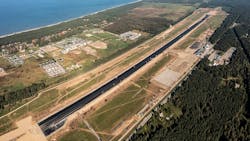Work of Asphalting Runway Completed at Palanga Airport
The reconstruction work of Palanga Airport, which has been started in early September, is proceeding according to the plan. Asphalting of the runway is now completed, the airport pavement marking works and works of installation of a more efficient system of LED signal lights are being started.
Both the upper layers of asphalt and the deeper sub-base layers have been replaced during the reconstruction of the runway, which is almost 2.3 km long and 45 m wide. All reconstruction works are carried out to ensure that the existing infrastructure meets the latest requirements for airports.
At present, about 150,000 square meters of the old pavement have already been replaced. More than 200,000 square meters of the old pavement will be replaced throughout the project.
Work of strengthening the foundations in the airport apron also has been completed. The installation work of the gutters of the surface run-off water collection networks are nearing the end, and work of asphalting will be initiated in the near future. The airport will have the possibility of collecting surface run-off water, and this is particularly important during the cold season of the year when, before taking-off, aircrafts are poured over with special anti-icing fluids.
“It can be said that the work of asphalting of the airport runway, that has been completed, is the crucial point in the context of the reconstruction of the air gate in Palanga, since this is the main part of the infrastructure whose life cycle was coming to an end, and it was necessary to modernize the runway. Following the substantial replacement of the pavement, this runway will be adapted for quality, safe and faster aircraft handling,” said Dainius Čiuplys, head of Operations and Infrastructure Department at Lithuanian Airports.
Armands Svikis, executive director of Latvian company A.C.B., which is carrying out the airport reconstruction work, says that the work of asphalting of the runway is among the most important in the entire process of the airport reconstruction and it requires significant capacity and precise planning.
“An operation of this scale has to be planned in detail in advance since the technical requirements for it are extremely strict and the process itself not only requires knowledge but also teamwork, which is done within strict time frames and without any delay. We set ourselves the highest quality requirements. Therefore, we have in our team the professionals who have gained the most experience in the field of airport reconstruction. Thanks to them, this part of the project will be implemented and completed on time,” said A. Svikis.
The entire airport infrastructure is cyclical. This means that the service life of the infrastructure covers a period of 10-15 years. At the end of this period, the existing parts need to be substantially upgraded. The last time the runway of Palanga Airport has been repaired in 2007.
It is recalled that, during the main phase of the modernization, Palanga Airport is closed, flights are not operated at the airport. This phase will last until October 20. After that, Palanga Airport will resume work and all flights will be operated as usually. The rest of the reconstruction work will be carried out until 1 December 2021, these processes will take place already in the airport that already operates.



